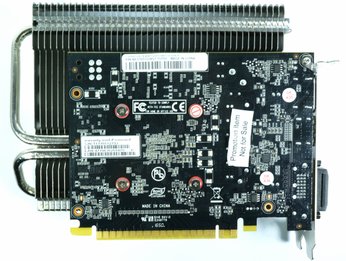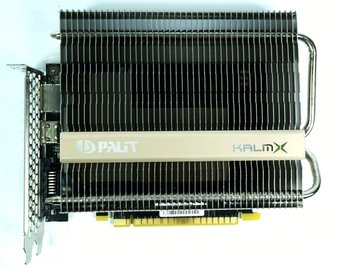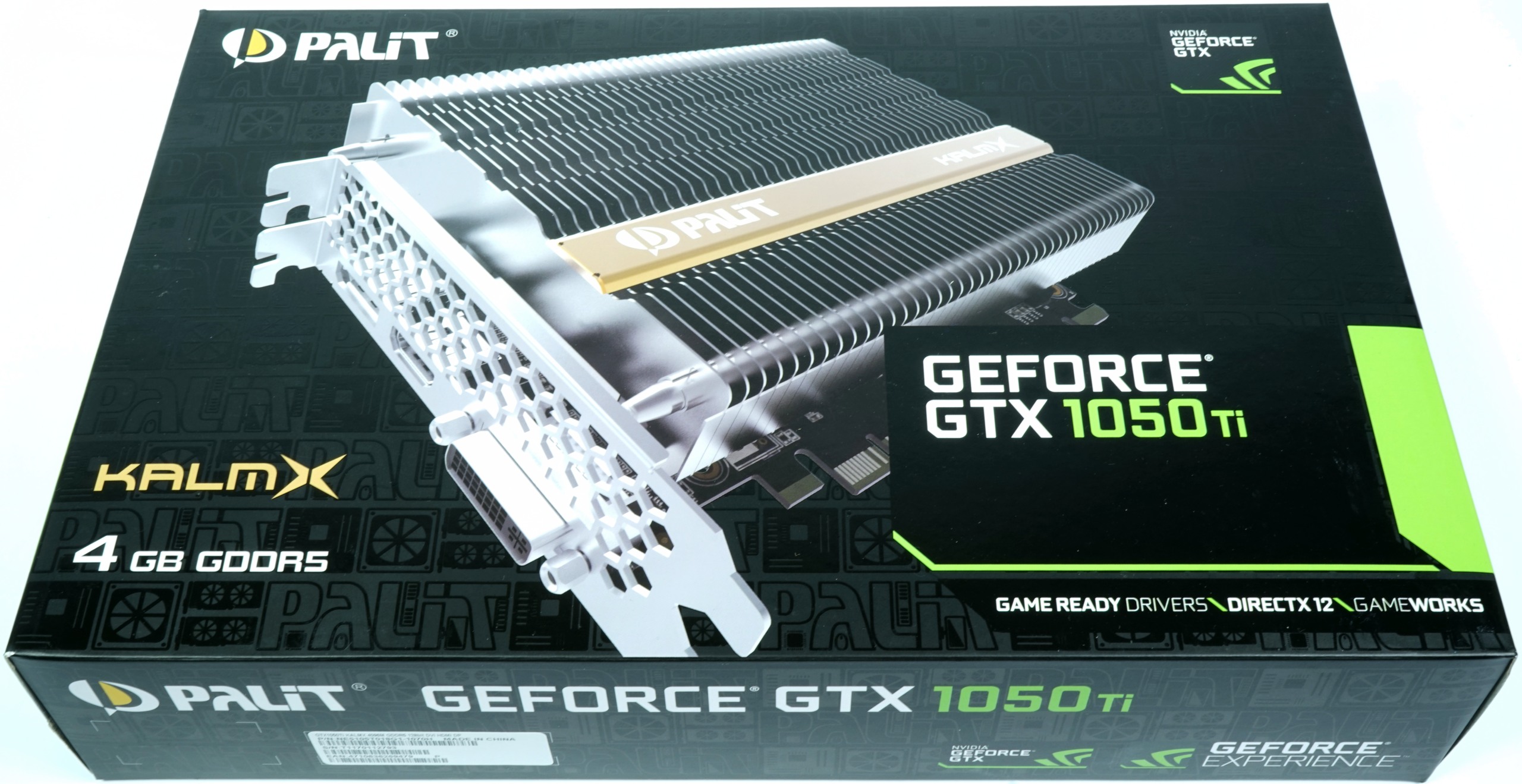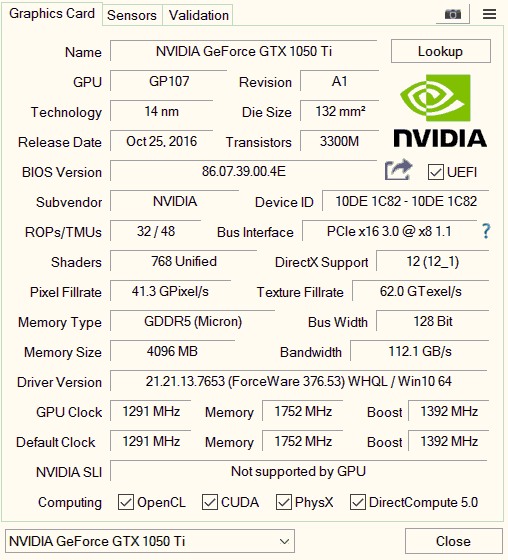Sneak Peek: Palit's Passively-Cooled GTX 1050 Ti KalmX 4GB
The GTX 1050 Ti KalmX builds on Palit's first passively-cooled card, the GeForce GTX 750 Ti. That was a 60W board, though; the 1050 Ti is rated for 75W. Can it still be cooled passively? Based on what we learned during our own Nvidia GeForce GTX 1050 Ti Passive Cooling Mod, we have some doubts. Without extra airflow, there's just too much heat to maintain full performance.
Palit's card works around this with a more conservative power budget, as you might guess from the missing six-pin connector. Because the PCB is borrowed from a standard GTX 1050 Ti, the pads for that connector are there--just unused. Still, Nvidia's GP107 processor operates at the 1050 Ti's reference 1,291MHz with a rated GPU Boost frequency of 1,392MHz.
The memory is configured at 1,752MHz, allowing Palit to leave the modules uncooled except by normal air circulation.
Weighing just over 16 ounces (466g), the card is fairly light, and with measurements of 7.2 x 5.4 x 1.4 inches wide (LxHxW), the dual-slot form factor should fit almost anywhere.


For a number of reasons, Palit didn't slap a plate on the back of its card. Chief among them is avoiding compatibility issues with CPU coolers in mini-ITX machines.
Two nickel-plated 6mm heat pipes in a copper sink dissipate thermal energy as evenly as possible through aluminum fins. The sink protrudes from the end and top of the PCB to facilitate better air circulation, and the fins themselves are oriented vertically, similar to past passive solutions from Palit. Although this promotes natural convection, it benefits less from front-to-back airflow in the chassis.
The fin alignment is most helpful when the card is installed vertically, as you'd see in many mini-ITX enclosures. In that case, the horizontal fins used on HIS' and XFX's passively-cooled Radeon RX 460 cards are at a disadvantage.
Get Tom's Hardware's best news and in-depth reviews, straight to your inbox.
There's quite a bit of space between the fins, which is typical for passively-cooled thermal solutions relying on natural convection.
Palit even directly cools its card's VRMs. As we mentioned, though, the memory modules don't receive this benefit. Instead, they rely on airflow in the case to remove heat.
Outputs are limited to one DVI-D port, one HDMI connector, and a full-sized DisplayPort interface. This leaves room for plenty of openings for ventilation. They're almost pointless, though, because the vertical fin orientation encourages air to move perpendicular to the output bracket.
Expect the GTX 1050 Ti KalmX 4GB to sell for around $150, although prices might be higher at first.
We're looking a face-off between Palit's card and passively-cooled Radeon RX 460s from HIS and XFX. On paper, the Nvidia-based board has the advantage based on clock rates and architecture, but we really need to determine if GPU Boost is still an effective performance enhancement when this card is installed in a case and under load.

Igor Wallossek wrote a wide variety of hardware articles for Tom's Hardware, with a strong focus on technical analysis and in-depth reviews. His contributions have spanned a broad spectrum of PC components, including GPUs, CPUs, workstations, and PC builds. His insightful articles provide readers with detailed knowledge to make informed decisions in the ever-evolving tech landscape
-
MCMunroe I don't care about passive cooled. I need a new half height GPU. I haven't seen any new half height cards since GTX 750, and the Radeon 7750 we end up getting.Reply -
Math Geek then you have not exactly looked. this card has been out for a while now https://www.msi.com/Graphics-card/GeForce-GTX-1050-Ti-4GT-LP.html#hero-overviewReply
as has this one https://www.msi.com/Graphics-card/GeForce-GTX-1050-2GT-LP.html#hero-specification
enjoy :) -
MCMunroe -->Math GeekReply
Those just came out and I was coming back to edit my comment, but you beat me too it. Tom's Hadn't mentioned it though. -
Math Geek yah been a couple months but not widely available in stores yet. but at least it exists. also note a bunch of shorter "mini" cards are available. for a full list of released models and specs you can reference this thread which has a ton of info on the cards available. http://www.tomshardware.com/forum/id-3047729/nvidia-geforce-gtx-1000-series-megathread-faq-resources.htmlReply -
photonboy Can anybody show a link to a STORE that sells the LOW PROFILE cards though?Reply
I tried to follow "Where To Buy" (USA) from the MSI site for 4GB model but didn't find any cards. I found links to STORES just not the cards at the stores. -
Math Geek same with amazon https://www.amazon.com/MSI-GTX-1050-TI-4GT/dp/B01N2W8MJ9Reply
obscure stores i know but they are for sale in the wild :)
newegg link cause as well since search feature is hard to use https://www.newegg.com/Product/Product.aspx?Item=N82E16814137081 ;) -
netsrac Does anyone know if Palit has North American distribution? I've looked everywhere, and their cards only seem for sale in Europe, middle East and Asia.Reply -
Math Geek not that i have seen. their webpage lists the UK as closest to north america you can buy http://www.palit.com/palit/wtbuy.php?lang=enReply
don't believe they sell here even under a different name. by the time you imported one from the UK or europe, you'd spend more than a comparable brand readily available here :(






